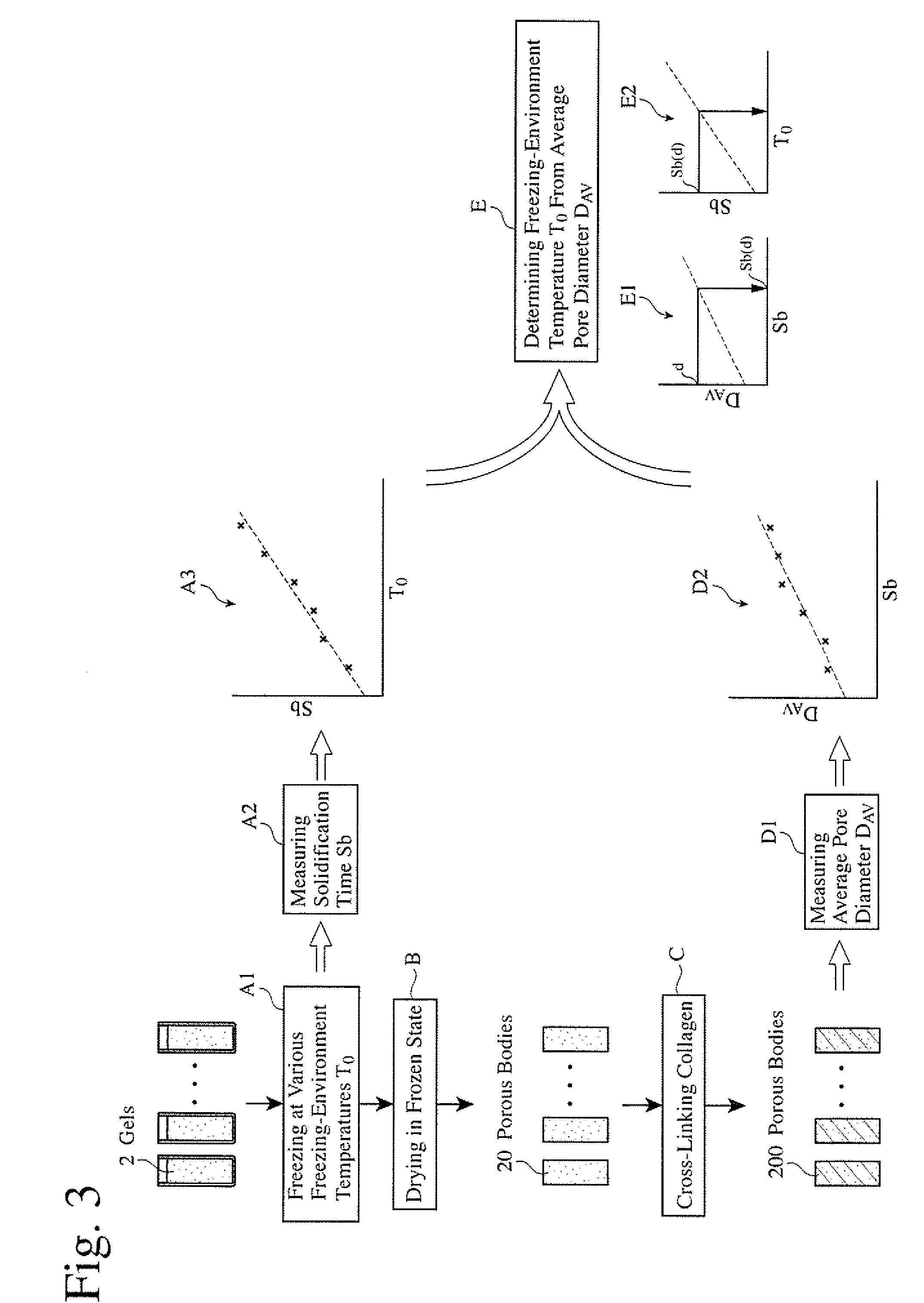Method for controlling average pore diameter of porous body comprising apatite/collagen composite fibers
a technology of collagen composite fibers and porous bodies, which is applied in the direction of prosthesis, other chemical processes, separation processes, etc., can solve the problems of bone fracture, hardness and brittleness of so-called artificial ceramic bone made only of apatite, and inability to completely match human bone mechanical properties and physiological properties with artificial ceramic bone such as apati
- Summary
- Abstract
- Description
- Claims
- Application Information
AI Technical Summary
Benefits of technology
Problems solved by technology
Method used
Image
Examples
example 1
(1) Production of Fibrous Apatite / Collagen Composite
[0062]412 g of an aqueous solution of collagen in phosphoric acid (concentration: 0.97% by weight, phosphoric acid: 20 mM) was added to 400 ml of a 120-mM aqueous phosphoric acid solution and stirred to prepare a solution I. 400 ml of a 400-mM calcium hydroxide solution (solution II) was also prepared. After 200 ml of pure water was charged into a reactor, the solutions I and II were simultaneously dropped thereinto. During dropping, a reaction solution was stirred, and the dropping speeds of the solutions I and II were controlled to keep the reaction solution at pH of 8.9-9.1. The resultant fibrous apatite / collagen composite was as long as about 1-2 mm. A slurry of fibrous apatite / collagen composite was freeze-dried. The apatite / collagen ratio of the fibrous apatite / collagen composite was 8 / 2 by mass.
(2) Production of Porous Body (a-1) Containing Fibrous Apatite / Collagen Composite
[0063]After 4.84 ml of pure water was added to 2 g ...
example 2
[0068]Porous bodies (a-2), (b-2) and (c-2) each containing a fibrous apatite / collagen composite were produced in the same manner as in the steps (1)-(3) in Example 1, except for changing the formulation of the starting materials as shown in Table 2. Any porous body had a solidification temperature of −5° C. to −1° C.
[0069]
TABLE 2AqueousFibrous1-NCollagen / Apatite / CollagenNaOHPhosphoric AcidNo.CompositeWaterSolutionSolutionPBSLiquid(1)Example 12 g4.84 ml0.06 ml2 g 1.61 ml95vol. %Example 24 g9.86 ml0.12 ml4 g1.529 ml90vol. %Note:(1)The amount of the liquid on a volume basis represents the total amount of pure water, the aqueous phosphoric acid solution, the aqueous NaOH solution and PBS per the dispersion containing a fibrous apatite / collagen composite.
[0070]FIG. 6 shows the relation between the freezing-environment temperature T0 (temperature in the freezer) and the solidification time Sb in the porous bodies (a-2), (b-2) and (c-2). As in Example 1, the solidification time Sb was subs...
PUM
| Property | Measurement | Unit |
|---|---|---|
| temperature | aaaaa | aaaaa |
| temperature | aaaaa | aaaaa |
| temperature | aaaaa | aaaaa |
Abstract
Description
Claims
Application Information
 Login to View More
Login to View More - R&D
- Intellectual Property
- Life Sciences
- Materials
- Tech Scout
- Unparalleled Data Quality
- Higher Quality Content
- 60% Fewer Hallucinations
Browse by: Latest US Patents, China's latest patents, Technical Efficacy Thesaurus, Application Domain, Technology Topic, Popular Technical Reports.
© 2025 PatSnap. All rights reserved.Legal|Privacy policy|Modern Slavery Act Transparency Statement|Sitemap|About US| Contact US: help@patsnap.com



